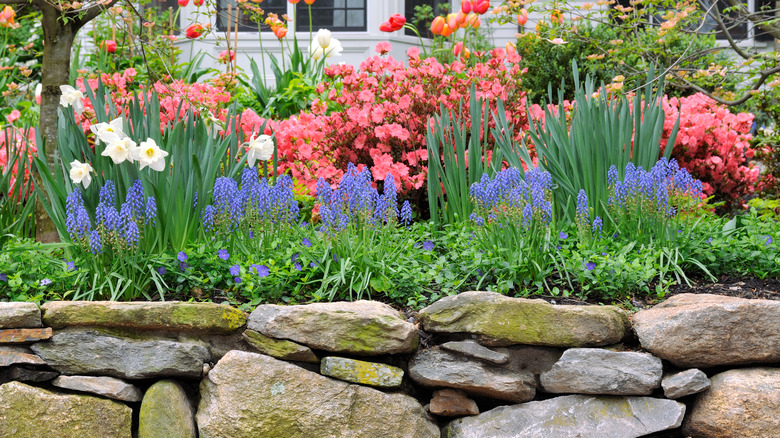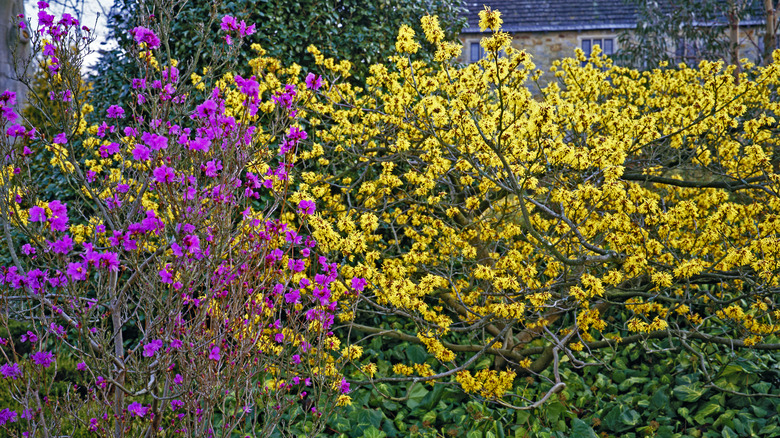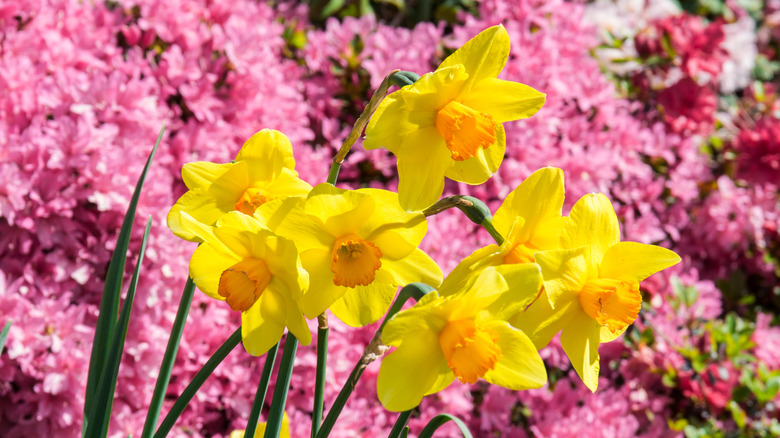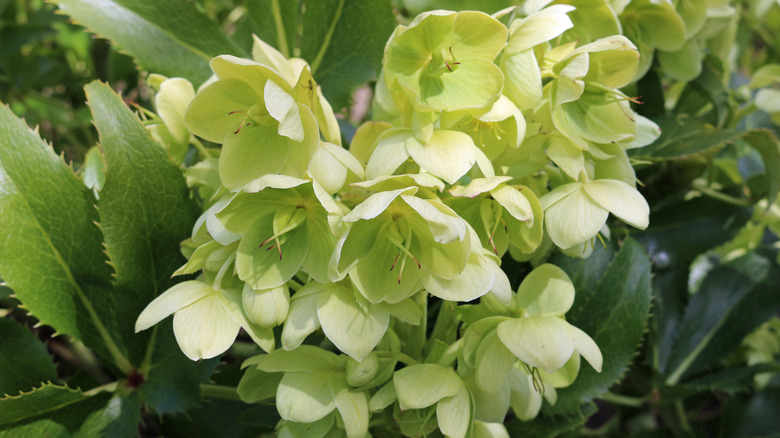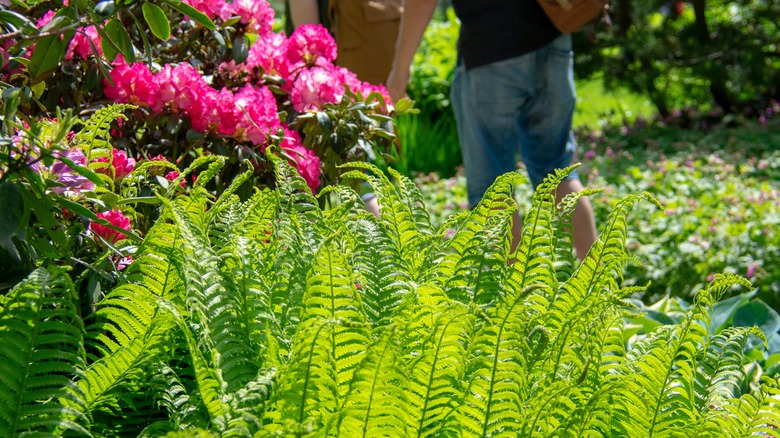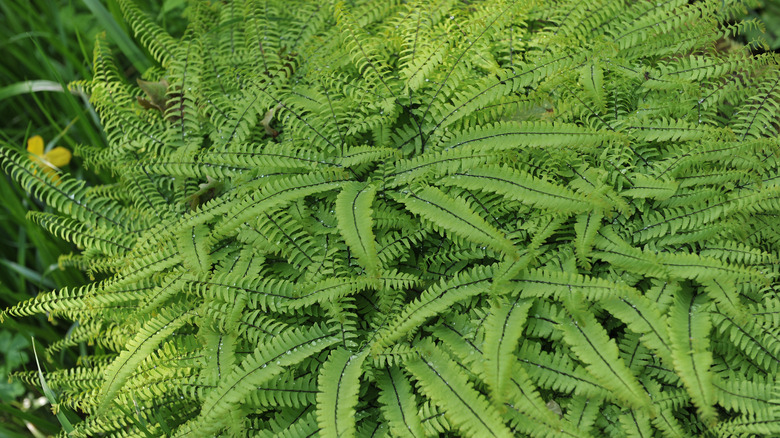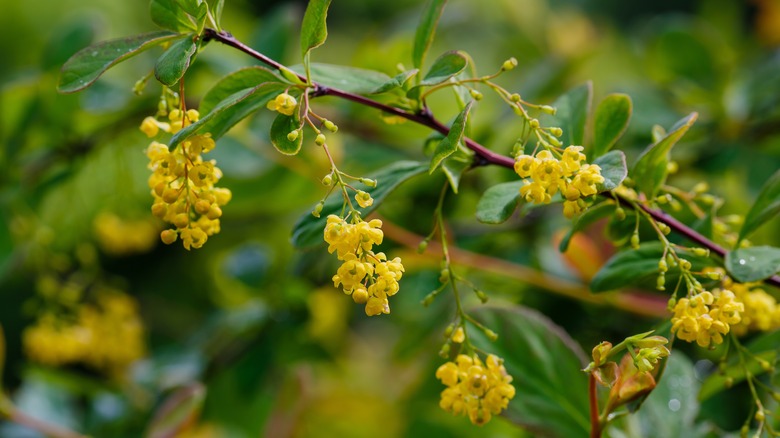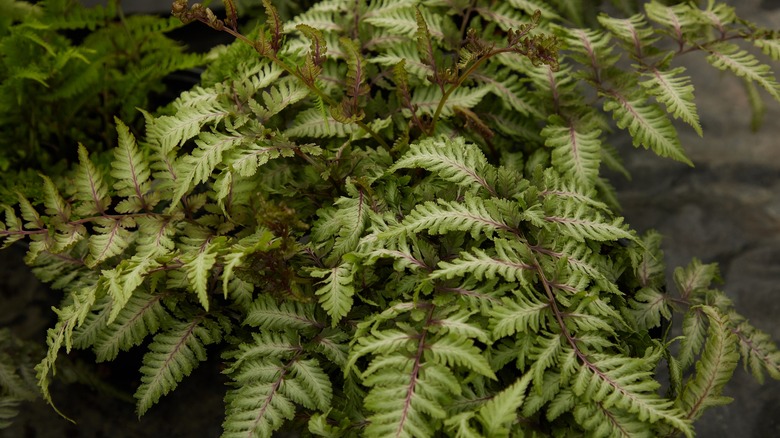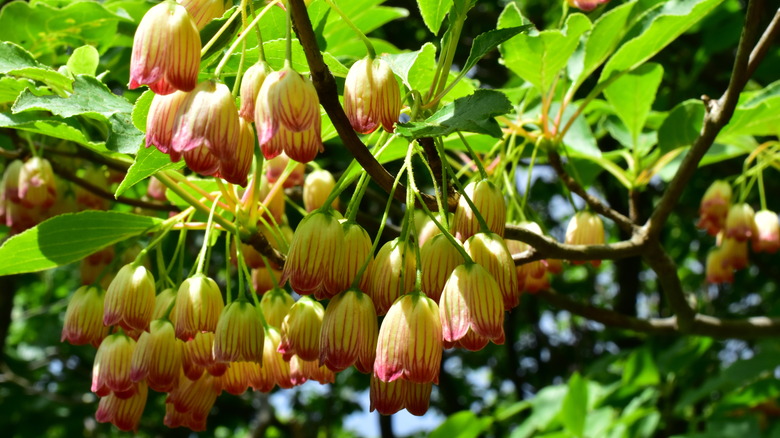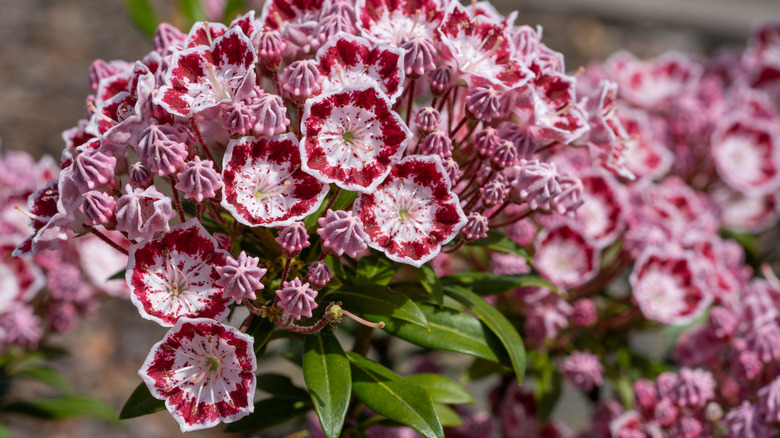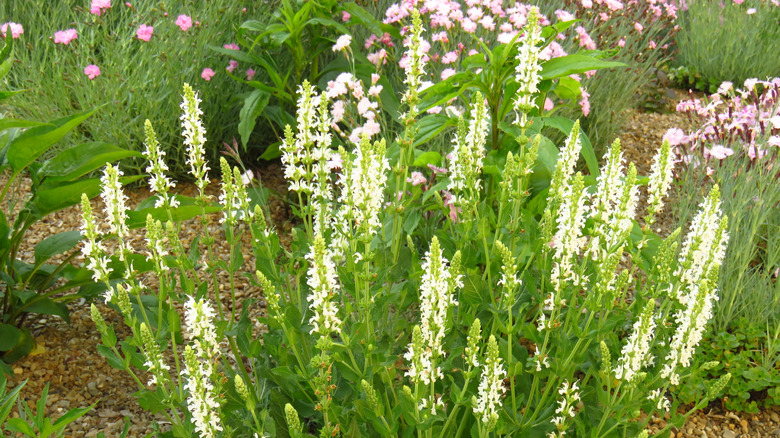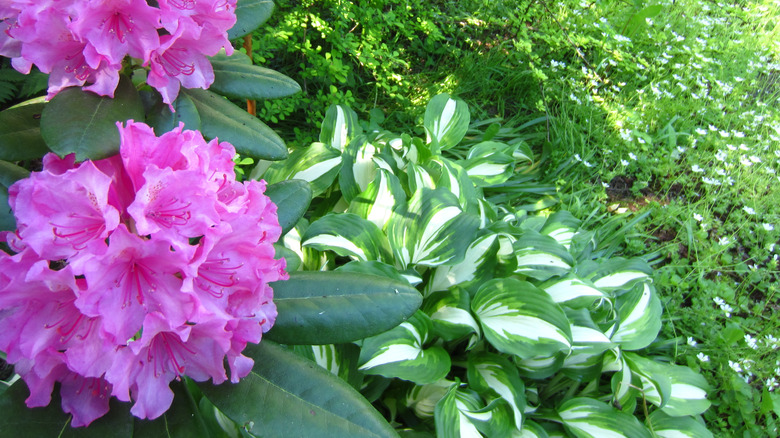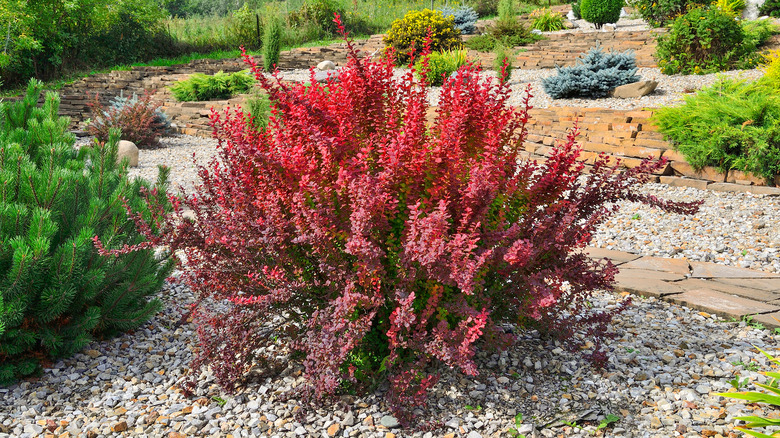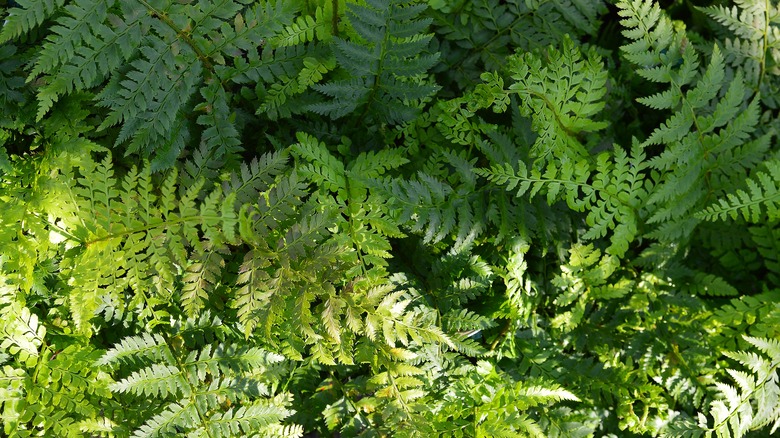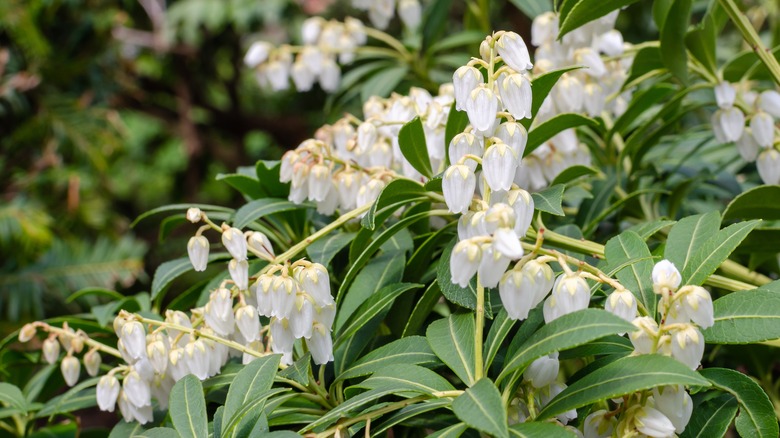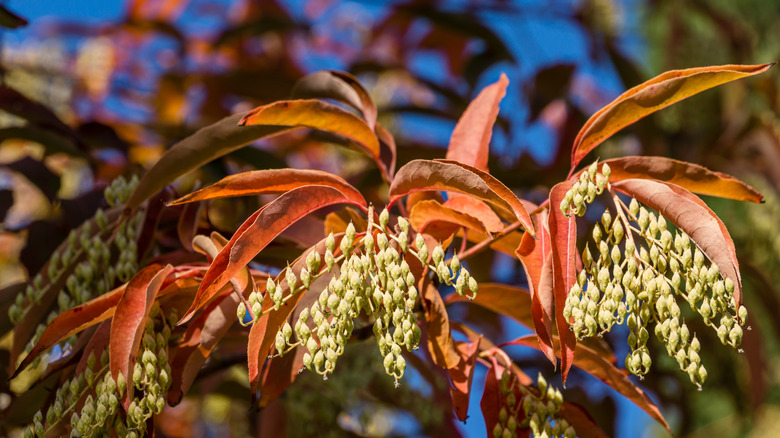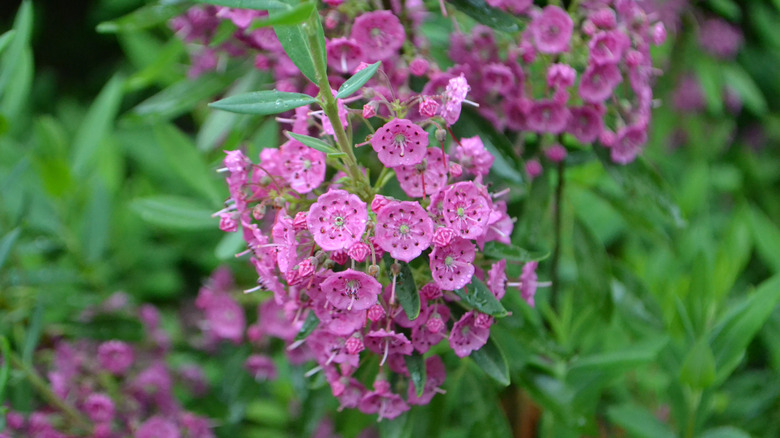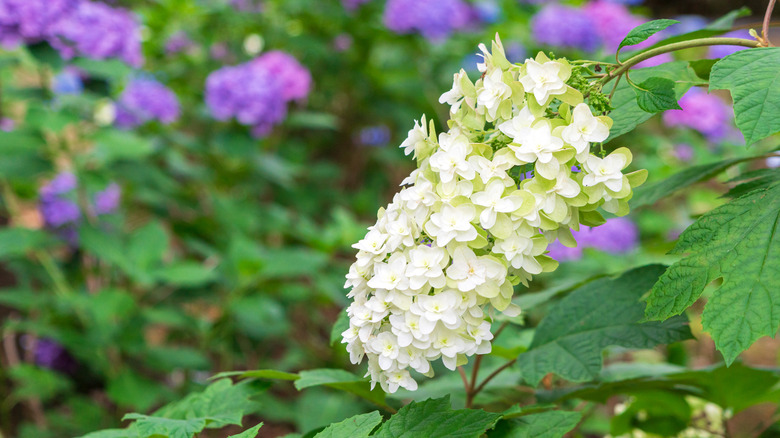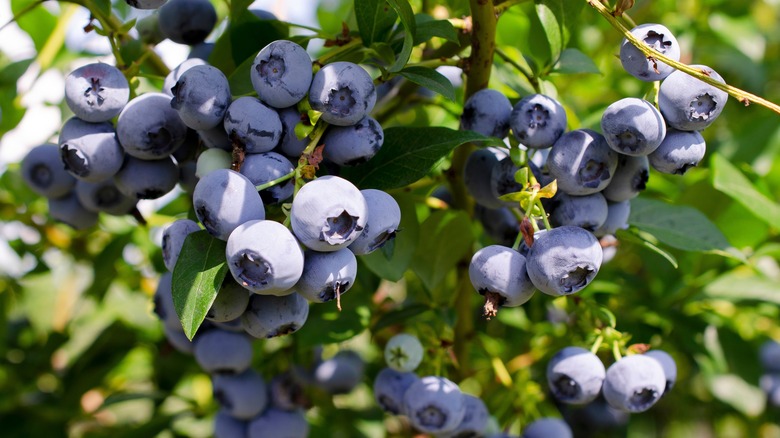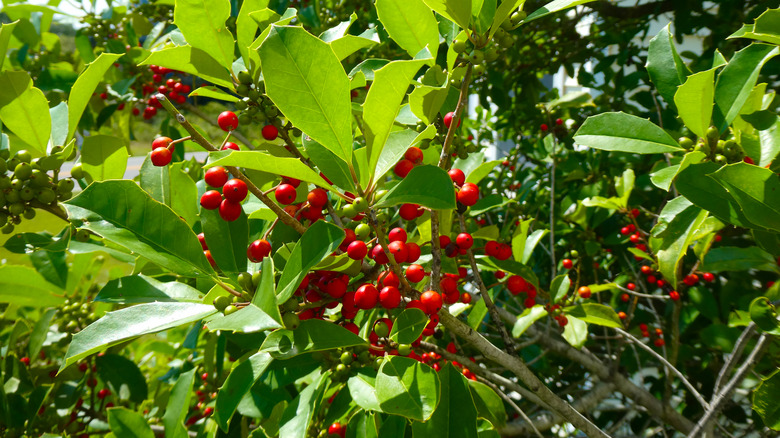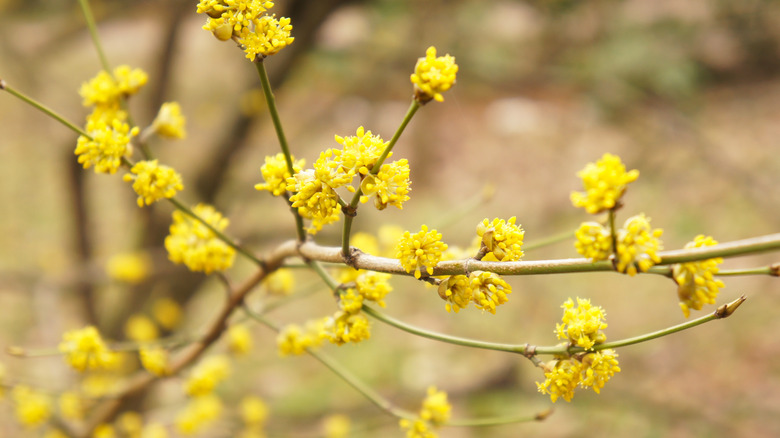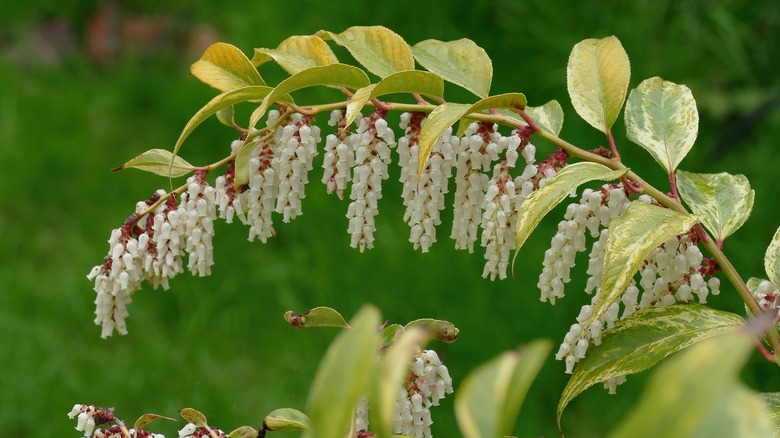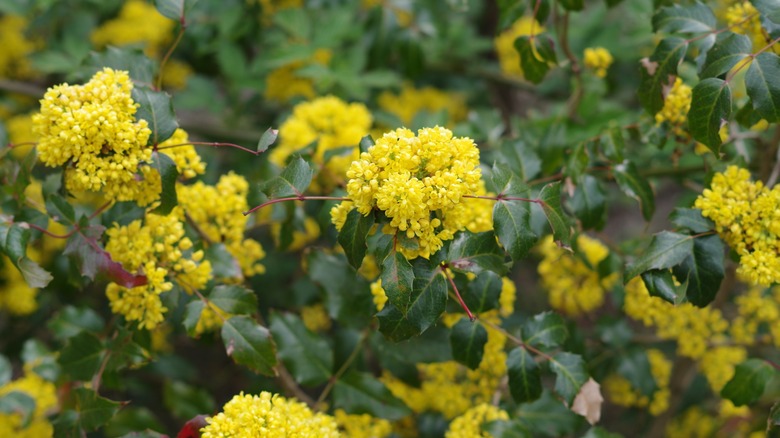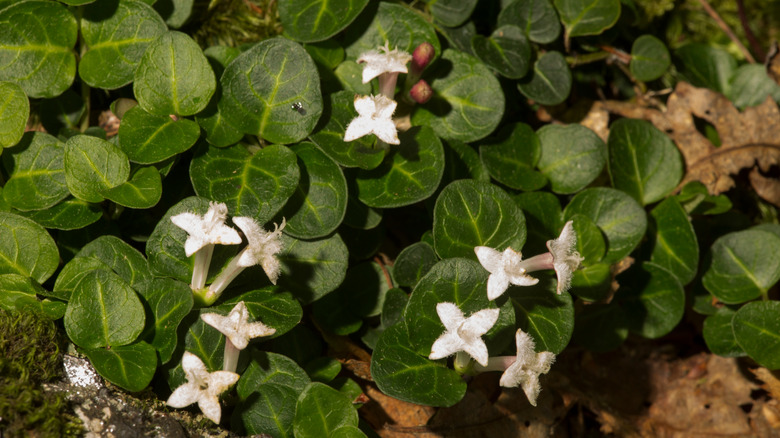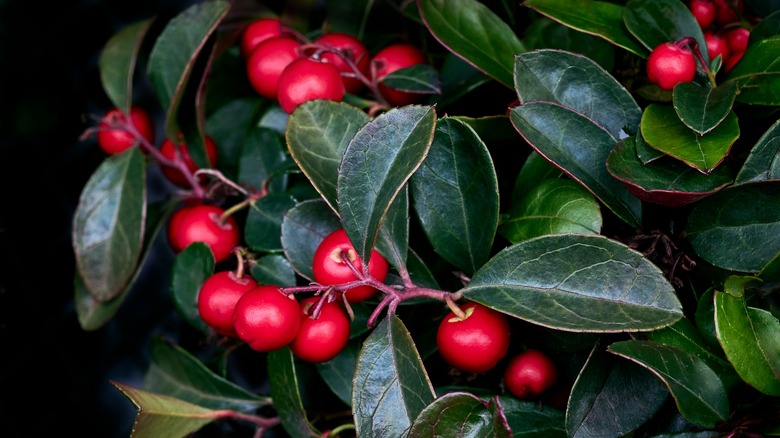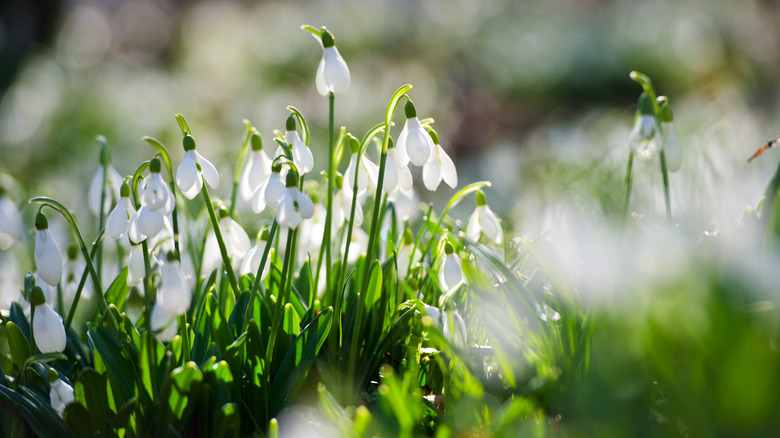Companion Plants That Thrive Next To Hardy Azaleas
Not too many bushes are as sought after as hardy azaleas, which bring many large and brightly colored flowers to your yard first thing in the spring. If you know that an azalea shrub is a must-have for your garden, you might be struggling to figure out which perennials and annuals are best for growing nearby. There are quite a few ornamental ferns, trees, bushes, and flowers that share the same needs as these rhododendron species do. They prefer shade, plenty of consistent watering, and well-drained soil amended with organic matter. Or, if they don't, they can quickly adapt to survive in the conditions that azaleas require.
Some companions for hardy azaleas, such as sourwood trees and spicebushes, come with more benefits like attracting additional pollinators. Others, including sweet pepper bushes, bloom or change their foliage color during seasons where rhododendrons aren't in bloom, helping you to maintain garden color for as long as possible. Depending on the advantages you're trying to reap when companion planting with azaleas, one or more of the many plant options below will be a good fit for your next garden design.
1. Witch hazel
Witch hazel trees (Hamamelis spp.) are well-suited to growing near azalea shrubs due to their relatively short growth habit, soil preferences, and root system that's unlikely to interfere with that of the rhododendron species'. While your azaleas steal the show in the spring and summer, your witch hazel tree will become very ornamental in the winter and fall when its leaves change color.
Bloom Season: Winter and fall
USDA Growing Zone: 3 to 8
Growing Conditions: Full sun or partial shade
Soil Type: Organically rich, moist, and well-draining
Size: 15 to 25 feet tall
2. Daffodils
Daffodils (Narcissus pseudonarcissus) and azaleas are a great match. The two spring-blooming plants complement each other nicely in the garden, as the shrub offers daffodils some shade, and the flowers act as a living mulch above the azalea's roots. Consider choosing varieties of the two species with flowers in similar shades for a bright display of yellow, pink, white, or orange blooms.
Bloom Season: Early to late spring
USDA Growing Zone: 3 to 8
Growing Conditions: Full sun to partial shade
Soil Type: Well-draining
Size: 6 to 16 inches tall
3. Corsican hellebore
Corsican hellebore (Helleborus argutifolius) is known for its pale green leaves and flowers that are often used in flower arrangements or grown ornamentally in the garden. The plant, which is also grown from a bulb, thrives alongside rhododendron species that enjoy a bit of shade and moist soil. In addition to companion planting with hardy azaleas, Corsican hellebore may also be planted beneath roses, hydrangeas, and some deciduous trees.
Bloom Season: Spring
USDA Growing Zone: 6 to 9
Growing Conditions: Full sun to partial shade
Soil Type: Well-draining
Size: 1 to 3 feet tall and wide
4. Ostrich fern
Ostrich ferns (Matteuccia struthiopteris) favor moist areas of the garden where they grow in the shade next to a pond or other water feature. Unlike some other ferns we cover in this collection, the ostrich fern grows large quickly and should be planted further away from your azalea bushes, so it can spread out without competing with the flowering bush. At maturity, the two plants complement each other's foliage.
USDA Growing Zone: 3 to 7
Growing Conditions: Partial to full shade
Soil Type: Moist and rich
Size: 3 to 6 feet tall and 5 to 8 feet wide
5. Maidenhair fern
The maidenhair fern (Adiantum pedatum) is a well-loved indoor and outdoor plant that is easy to care for. When planted in well-draining, but evenly moist soil, with plenty of shade, the fern sends out bright green fronds covered in small leaves. Grown as an understory plant for an azalea bush, the maidenhair fern will reward you with some incredible foliage that lasts most of, or all, year depending on your climate.
Bloom Season: Summer
USDA Growing Zone: 3 to 8
Growing Conditions: Partial to full shade
Soil Type: Moist and well-draining
Size: 1 to 2 feet tall
6. Korean barberry
Though lots of gardeners suggest growing barberry plants as companions to azaleas, few specify that the Korean barberry plant (Berberis koreana) is among the best species to pick. Compared to other barberry bushes, this one offers wonderful foliage colors in the fall as well as edible berries around the same time. Additionally, Korean barberries are spring-blooming plants that produce yellow blossoms at the same time your azaleas are flowering.
Bloom Season: Spring
USDA Growing Zone: 3 to 7
Growing Conditions: Full sun to partial shade
Soil Type: Well-draining
Size: 3 to 5 feet tall and wide
7. Japanese-painted fern
Japanese-painted ferns (Athyrium niponicum var. pictum) are known for their long fronds and colorful foliage that ranges from a silvery-green to a deep red color. The tropical-looking plant grows well in shaded locations that offer rich and moist, but well-draining, soil. Like other ferns in this collection, Japanese-painted ferns look best planted beneath a larger azalea bush.
USDA Growing Zone: 3 to 8
Growing Conditions: Partial to full shade
Soil Type: Humusy, rich, and well-draining
Size: 1 to 2 feet tall and wide
8. Red vein enkianthus
A member of the blueberry family, red vein enkianthus (Enkianthus campanulatus) can act as a companion to an azalea species. Due to its tall habit, it can cast shade on the flowering bush, which needs protection from the hot and drying sun. The small tree is deciduous, so it will lose its canopy of foliage as winter approaches, but not before it shows off its gorgeous color-changing leaves.
Bloom Season: Spring
USDA Growing Zone: 4 to 7
Growing Conditions: Full sun to partial shade
Soil Type: Moist, rich, and well-draining
Size: 6 to 16 feet tall
9. Mountain laurel
Mountain laurel (Kalmia latifolia) is hardy azalea's bestie. The medium-sized bush produces red, white, and pink flowers among bright green and glossy leaves. Partnered with the azalea bush's various blooms and darker green leaves, the two heighten each other's visual interest. Both can be planted as foundation bushes along the front of your home to welcome guests and increase your house's curb appeal.
Bloom Season: Spring and summer
USDA Growing Zone: 4 to 9
Growing Conditions: Full sun to full shade
Soil Type: Rich and well-draining
Size: 4 to 15 feet tall and 4 to 8 feet wide
10. Sweet pepper bush
If you are trying to keep your garden colorful for as long as possible, consider planting fall or summer-blooming plants, such as sweet pepper bush (Clethra alnifolia), with your azaleas. When your rhododendrons finish blooming after three weeks in the early or mid-spring, a plant like this can swoop in and pick up right where the other flowers left off so your garden stays colorful throughout the year.
Bloom Season: Summer
USDA Growing Zone: 4 to 9
Growing Conditions: Full sun to full shade
Soil Type: Moist and well-draining
Size: 3 to 8 feet tall
11. Hostas
Hostas (Hosta plantaginea) are frequently planted beneath, or as a neighbor to, hardy azaleas. Their wide, fleshy foliage perfectly complements the flowering shrub's small green leaves and large blooms that appear to cluster together on the plant's many stems. These two, which share similar growing requirements, you'll find are simple to grow together as the care for one is just the same as the other.
Bloom Season: Mid-summer
USDA Growing Zone: 3 to 9
Growing Conditions: Partial shade
Soil Type: Moist, organic, and well-draining
Size: 2 inches to 3 feet tall and 4 inches to 5 feet wide
12. Japanese barberry
The Japanese barberry shrub (Berberis thunbergii) doesn't share all the same interests as rhododendron bushes, but it is adaptable enough to be grown alongside these prolific bloomers if you want to see these two planted next to each other. Japanese barberry shrubs look amazing next to azaleas, particularly in the fall, when they will steal the show with their color-changing leaves.
Bloom Season: Spring
USDA Growing Zone: 4 to 8
Growing Conditions: Full sun
Soil Type: Well-draining
Size: 3 to 6 feet tall and 4 to 7 feet wide
13. Braun's holly fern
Ferns, such as Braun's holly fern (Polystichum braunii), are always an option for planting beneath rhododendron bushes. Their bright and feathery foliage adds great interest below the azalea's flowers, and they actually enjoy growing underneath the bushes. Here, they are provided with the shade, moisture, and cool temperatures that they need to survive.
USDA Growing Zone: 3 to 8
Growing Conditions: Partial to full shade
Soil Type: Average and moist
Size: 2 to 3 feet tall and wide
14. Japanese andromeda
Another Japanese shrub, Japanese andromeda (Pieris japonica) is frequently recommended for companion planting alongside hardy azalea bushes. The broadleaf evergreen native to Japan, Taiwan, and Eastern China is well-suited to growing in the same soil and climate conditions as rhododendron plants. On top of this, its white spring flowers look incredible next to azalea's trumpet-shaped blossoms.
Bloom Season: Spring
USDA Growing Zone: 5 to 8
Growing Conditions: Full sun to partial shade
Soil Type: Rich, moist, and well-draining
Size: 9 to 12 feet tall and 6 to 8 feet wide
15. Sourwood
Sourwood (Oxydendrum arboreum) makes for a wonderful over-story plant when grown above azalea bushes. The relatively short tree offers necessary shade and pollinator-attracting blooms to your yard, so your flowering shrubs can grow healthily. Like rhododendron plants, the sourwood tree also enjoys rich and moist soil. Due to this, as well as the tree's relation to the species, growing these two together is a breeze.
Bloom Season: Summer
USDA Growing Zone: 5 to 9
Growing Conditions: Full sun to partial shade
Soil Type: Moist, rich, and well-draining
Size: 20 to 50 feet tall and 10 to 25 feet wide
16. Sheep laurel
A relative of mountain laurel, sheep laurel (Kalmia angustifolia) can also be a good pairing for rhododendron species. This plant, which grows best in moist and boggy sites in direct sunlight, is known for its showy spring and summer-blooming flowers that blossom in shades of pink, red, and purple. Planted next to azaleas, this native shrub species benefits the former by bringing in local pollinators and other beneficial insects.
Bloom Season: Spring and summer
USDA Growing Zone: 5 to 8
Growing Conditions: Full sun to partial shade
Soil Type: Moist and organic
Size: Up to 5 feet tall
17. Oakleaf hydrangea
You'll get the biggest blooms for your buck if you pair an oakleaf hydrangea plant (Hydrangea quercifolia) with an azalea bush. Both large shrubs are known for their abundant flowers and love of shade. Planted as neighbors, the two will provide you with flowers from early spring to late fall due to their mostly separate bloom seasons.
Bloom Season: Summer to winter
USDA Growing Zone: 5 to 9
Growing Conditions: Partial to full shade
Soil Type: Fertile and well-draining
Size: 6 to 8 feet tall and wide
18. Highbush blueberry
The highbush blueberry bush (Vaccinium corymbosum) can be a good match for your hardy azalea plant. Like the rhododendron, this blueberry-producing plant needs cool temperatures and moist soil to thrive. However, it does require access to direct sunlight. Because the highbush blueberry bush typically grows a couple of feet taller than most azalea shrubs, providing one with shade and the other with sunlight isn't difficult.
Bloom Season: Late spring to early summer
USDA Growing Zone: 4 to 7
Growing Conditions: Full sun to partial shade
Soil Type: Well-drained and organic
Size: 6 to 12 feet tall
19. American holly
American holly (Ilex opaca) makes for a good over-story planting above an azalea bush. The broadleaf evergreen, traditionally used for holiday decorations, is capable of providing the flowering bush with the shade that it needs to grow properly. By keeping the azalea bush out of too much direct sunlight, the companions offer more flowers, foliage, and healthy growth.
Bloom Season: Spring
USDA Growing Zone: 5 to 9
Growing Conditions: Full sun to partial shade
Soil Type: Moist and well-draining
Size: 15 to 30 feet tall and 10 to 20 feet wide
20. Spicebush
The spicebush (Lindera benzoin) is recommended for planting alongside rhododendron species due to its tolerance for heavy shade and ability to be planted in less-than-ideal garden spaces. Next to azaleas, spicebushes complement their early blooms with a set of their own fragrant yellow flowers. With both of these shrubs in bloom at the same time, you can expect a larger population of pollinators and beneficial insects in your flourishing garden.
Bloom Season: Spring
USDA Growing Zone: 4 to 9
Growing Conditions: Full sun to full shade
Soil Type: Moist and well-draining
Size: 6 to 12 feet tall and wide
21. Drooping leucothoe
Drooping leucothoe (Leucothoe fontanesiana), also known as fetterbush and doghobble, is a fairly large shrub that grows near rivers and stream banks. The water-loving plant is surprisingly adaptable in the garden as it can grow in full sun, full shade, and a few different soil types. As long as the drooping leucothoe is kept moist, it will grow successfully next to your hardy azaleas.
Bloom Season: Spring
USDA Growing Zone: 4 to 6
Growing Conditions: Full sun to full shade
Soil Type: Moist and acidic
Size: 2 to 6 feet tall and 4 to 8 feet wide
22. Oregon grapeholly
Oregon grapeholly (Mahonia aquifolium) is native to the United States, and it is frequently found growing in the Pacific Northwest. The small shrub is easily identified by its holly-like leaves and yellow flowers, which are recognized as the state flower of Oregon. Because it prefers shady, moist, and cool growing locations, it can be planted near azaleas for some added texture and color in your garden.
Bloom Season: Spring
USDA Growing Zone: 5 to 8
Growing Conditions: Partial to full shade
Soil Type: Moist and well-draining
Size: 3 to 10 feet tall
23. Partridgeberry
The partridgeberry plant (Mitchella repens) is typically used as ground cover in small, moist, and shady locations. Its mat-forming, but not aggressive, habit makes this plant good for growing beneath hardy azaleas that enjoy the same conditions as the partridgeberries. In addition to the rhododendron species' large clusters of flowers, this short-growing plant offers bright red berries and fragrant white blooms.
Bloom Season: Spring to summer
USDA Growing Zone: 3 to 8
Growing Conditions: Partial to full shade
Soil Type: Rich, moist, and well-draining
Size: 3 inches tall and 6 to 12 inches wide
24. Teaberry
Teaberry (Gaultheria procumbens) is another low-growing plant that benefits from azaleas' large growth habit, which casts a considerable amount of shade for those growing below its foliage. The teaberry plant is known for its unique urn-shaped flowers and red berries that appear in the fall. Planted as a partner to rhododendron species, the creeping perennial benefits from being grown in the same moist and shaded environment.
Bloom Season: Summer
USDA Growing Zone: 3 to 7
Growing Conditions: Partial to full shade
Soil Type: Moist and well-draining
Size: 4 to 8 inches tall and 6 to 12 inches wide
25. Snowdrops
If you have seen snowdrop flowers (Galanthus spp.) being grown beneath large deciduous trees, you may be wondering what others they can be planted with. Azalea bushes are one of them. The bulbs grow nicely with the rhododendron species as they won't challenge the shrub for space, nutrients, or water. Snowdrops should begin to bloom just before the flowering bush, so you can enjoy a bold display of color when the snow melts.
Bloom Season: Winter to spring
USDA Growing Zone: 3 to 8
Growing Conditions: Full sun
Soil Type: Rich and well-draining
Size: Up to 10 inches tall
